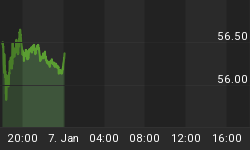The Federal Reserve released the minutes of the May FOMC meeting. The discussion noted that consumer spending had started to moderate and residential housing had cooled. Consumer spending was thought to slow going forward due in part to weaker home price appreciation and higher energy prices. It is expected that gains in employment and personal income growth will give support to spending. While consumer spending has cooled, the manufacturing sector continued to expand. There was significant discussion regarding inflation and inflation expectations. It was noted that some measures of inflation expectations were up, but other were "little changed." With inflation starting to gain momentum, it has clearly become the focus of the Fed and investors. The heightened risk of inflation sparked the discussion whether the Fed should raise rates by 50 basis points, before ultimately deciding on another 25 basis points. After hearing that a 50 basis point increase was even discussed, traders pushed up the probability of two more rate hikes this year to 26% from no chance last week.
Wal-Mart announced that May same store sales likely rose 2.3%. This was near the low-end of its guidance of 2% - 4%. Wal-Mart noted that higher energy prices are impacting its customers and said it has seen "more pronounced paycheck cycles." Last month, retailers benefited from the shift of Easter. This helped Wal-Mart boost comps by 6.8%. In fact, most retailers experienced a boost in sales. The International Council of Shopping Centers reported that year-over-year chain store sales increased 4.7% in April. Wal-Mart's sales might prove a warning for May sales. The latest tally from the ICSC showed that chain store sales increased 3.6% last week. Additionally, the trade organization lowered its forecasts for May sales to 3% from 3.5%.
Higher energy costs are one reason that retail sales have lost some traction. It is also starting to impact consumer confidence. The Conference Board reported that consumer confidence dropped 6.6 points to 103.2 in May, but was higher than the 101 economists forecasted. Most of the decline was due to reduced optimism regarding the future. The expectations component dropped 8.6 to 83.7, while the present situation fell 3.7 points to 132.5 from April's five-year high. In attempts to justify reasons for the Fed to pause, economists were quick to point out that 20.5% of respondents felt jobs were hard to get, up from 19.7% last month. Last month's level was the lowest since September 2001 and is down from the 35.1 reached in September 2003.
The latest survey of Chicago purchasing managers provided evidence that the manufacturing sector expanded in May. The headline index rose 4.3 points to 61.5, which was the highest since October 2005. The biggest increases were in new orders (up 8.8 points to 69.6) and order backlog (up 11.2 to 56). This was the strongest level of new orders since March 2005. Employment rebounded 5.6 points to 52.8 after 8.4 points in April. Prices paid dropped slightly to 76.9, but this shows that manufacturers continued to battle higher prices.
Hovnanian Enterprises reported that its second-quarter earnings dropped 2.4% on a 30% increase in revenue, due to gross margin contracting by 270 basis points. It joined a growing list of builders that took write-offs associated with land. In its press release the company said it has renegotiated its options contracts on several parcels, "primarily those negotiated within the last twelve months that no longer adequately reflect the pricing and returns available in the current sales environment." The company said that it "walked away" from $5.6 million worth of deposits when it was unable to renegotiate the terms. New orders dropped 19% with the dollar value of new contracts fell 18%, with average price up fractionally. Orders dropped the most in the West, down 41%, and the Southeast (down 18%). The drop in new orders was in light of a 33% increase in the number of communities. The average selling price in both these regions had the largest increase, up 14.8% and 12.9% respectively. In fact, Hovnanian had price increases in all four of its regions. The flat pricing for the overall company was due to a 32% drop in the average price in homes sold in its unconsolidated joint ventures.
The automakers will report May sales on Thursday. Analysts are expecting sales to be slightly down from last month at an annualized rate of 16.5 million vehicles. In aggregate, the domestic automakers are expected to post declines of about 4% and the Asians are likely to increase sales by 6%.
It is clear that the economy is at an inflection point. Consumer spending is the most important driver to economic growth and is starting to slow. Additionally, inflation has continued to rise at an elevated rate and has shown signs on accelerating. The bet being placed right now is that the higher prices will slow economic growth, which would elevate the upward pressure on prices. Unfortunately, the global economy has continued to expand and will maintain pressure on energy and commodity prices.















